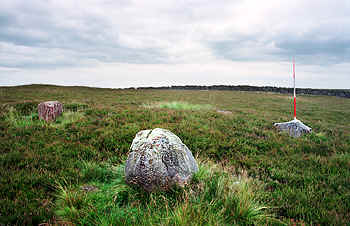
 |
Photo Gallery |
|
Panoramas |
||
3D Vision |
||
| NU 09350 27517 (GPS 31min). | Diameter 6.4m N-S (Meas. SC) |
| Visited July 2003 | No magnetic anomalies |
Whinny Hill is an obscure site, incorrectly given a Perthshire map reference in Burl's gazetteer (2000), and not shown at all on the 1:50,000 OS maps, we located it safe and reasonably sound, in darkest Northumberland.
The circle stands on Chatton Moor about 9km east of Wooler in an area saturated with prehistory. The high quality rock art sites of Chatton, Old Bewick, Weetwood Moor and Doddington Law are all within a 10km radius, the stone circles at Threestones Burn and Hart Heugh are only 14km to the SW and that at Doddington Law only 9km to the NW. Whinny Hill itself is dotted with the low mounds of cairns and there is an Enclosed Cremation Cemetery only 200m to the NE.
The circle lies just south of the summit of Whinny Hill with panoramic views from the sea in the east, to the Cheviots in the west. Four stones were visible at the site during our visit, three large stones almost exactly at N,S,W and a small partly buried stone at the SE. The tallest stone is at the west and is 0.8m high, the northern stone is 0.6m tall and the southern stone is just under 0.5m tall. The northern stone is very striking, being composed of red granite and with the particular lighting conditions we were viewing it under, the stone almost seemed to glow. All of the other stones are grey in colour and the western stone has several circular depressions on its upper surface, but we think that these are most probably the result of erosion and are not genuine cupmarks.
At the east is a large hole about the size of one of the circle stones, its sides and bottom had a smooth moulded appearance and given its position on the circle circumference we at first thought that a stone had been removed recently. This belief was further strengthened by the "ruff" of grass that surrounded the hole, the circle stands on dense heather moor and the only other patches of grass anywhere near were those around the three large circle stones. The circle was reported to the local SMR in 1995 and the description mentions four stones, so if a stone has been removed in modern times this must have occurred over eight years ago. The SMR report does mention two sockets, but we could only find the one, we also failed to find an outlier which is described as being "34 paces away" to the SE.
Given the cardinal arrangement of the remaining large stones and the eastern hole, it is tempting to think of this circle as being a four poster, a type well represented amongst surviving Northumbrian circles. However, if the report of two stone-holes is accurate and the small stone at the SE is included, then a more mainstream plain ring is probable.